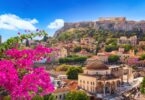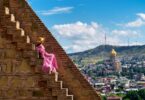Close to a remote Himalayan valley in India, just over the border from Tibet, you’ll stumble upon what very well could be heaven. Here in the Valley of Flowers National Park, visitors make the once-before-I-die trip to see 300 species of flowers creating nature’s own version of magic carpet. With the snowy peaks completing the scene, it’s no wonder so many travelers go out of their way to reach this wonder. And as the local villagers once believed about the space, you’ll think it was all the work of fairies once you get there.
But there’s much to know before you venture out into this floral paradise. That’s why we’ve created a guide on India travel tips. That way, when you visit the Valley of the Flowers, you’ll be able to stop and smell the roses — or rather, the daisies, marigolds, orchids, poppies, and primulas — without a hitch.
What is the Valley of the Flowers?

Where is the Valley of the Flowers?

The best kinds of attractions are tucked away, ones that require a little bit of effort to reach. The Valley of Flowers National Park is one of those attractions: it sits about 400 miles from Delhi. The national park rests in Chamoli Garhwal in India’s state of Uttarakhand. The Valley of Flowers National Park is also quite close to Nanda Devi National Park.
When Should I Go to the Valley of the Flowers?

The Valley of Flowers National Park is certainly not an attraction that you can visit at just any time of year. In fact, it’s only open from June until October. The best time to visit tends to be from mid-July to mid-August — when the flowers are at their peak. Visitors who come before mid-July or after mid-August tend to be disappointed, as they aren’t able to get the full effect of the flowers. The colors also tend to vary depending on when you visit. June boasts more red and pink flowers, while July’s glow warm yellow.
What Should I Bring?

Although a trek through the Valley of Flowers might seem a little daunting at first, it is no more challenging than hiking through any other national park in the world. By far the most important travel tips are to bring extra clothing, especially those with lots of layers, as well as rain gear. Weather conditions only permit access to the Valley of Flowers from the beginning of June until the end of September each year, a time that also coincides with monsoon season in India. Experts recommend that in the event of a sudden rainfall, visitors have a spare change of clothes to make their day more enjoyable.
Additionally, a raincoat and waterproof packs and boots are also recommended for anyone planning to make the trek through the valley. Along with rain gear, experts also suggest standard equipment for hiking, such as a first-aid kit, water bottle, and sunscreen. Money is also important for a trip to the Valley of Flowers. In addition to permit fees, hiring a mule and a guide can cost several thousand rupees. (Don’t worry, though. That’s about $25 USD.)
How Do I Get There?

Tourists have several options for how to arrive for their trip through the Valley of Flowers. By far the most common way visitors get there is by is air travel. The region is serviced by Jolly Grant Airport in Dehradun, some 183 miles from the Valley. Most visitors arriving by plane either rent a car or hire a taxi to make the rest of the trip to Govindghat, the last major town with connecting roads to the valley.
When arriving by train, tourists must stop at the station of Rishikesh, 169 miles from the Valley of Flowers, and then make the rest of the journey by car to Govindghat. Travelers on a budget can also choose to take the bus to Govindghat from countless locations in India. Buses from New Delhi, for instance, are readily available. Many tour operators offer packages for budget-minded visitors. Shareable jeeps are also available for those traveling by road.
Where Should I Stay?

Joshimath, India
Most visitors choose to stay in accommodations of the nearby villages of Joshimath and Govindghat. The majority of places that cater to tourists in the area are homestays, small hotels that are similar to a bed and breakfast. Among the most popular places for tourists is the Himalayan Abode, a homestay in Joshimath famed for its beautiful architecture and mountain views. Visitors will enjoy having their own kitchen and bathroom as well as access to the hotel’s staff, who have a deep knowledge of the surrounding mountains and the region’s customs.
Guests looking for a higher-end experience should consider Joshimath’s Nanda Inn, which offers rooms with balconies overlooking serene gardens and the chance to participate in yoga classes. While camping isn’t allowed in the Valley of Flowers, tourists looking for more rugged accommodations can stay at the Blue Poppy cottage camp in Ghangaria. Complete with double beds and electricity, tents at Blue Poppy allow visitors to rest in the shade of the Valley of Flowers’ incredible foliage.
You Might Also Enjoy: India by the Bloom: The Eye-Popping Flower Festivals and Events You’ll Want to See and Smell
What Are the Best Hikes and Trails?

Visitors of the Valley of Flowers have their pick of some of the most picturesque hikes and trails in the world. For most visitors, the Valley of Flowers Trek is the most popular hike in the park. The Trek encompasses 25 miles between the town of Govindghat and the village of Ghangaria. This trail is also considered a moderately challenging hike due to the steadily increasing elevation of the path. Visitors are nevertheless rewarded with spectacular views of the region’s wildflowers, which grow in abundance in the grasslands adjacent to the path.
More experienced hikers should also consider the Kunth Khal Trek, a 9-mile route that puts the focus on the amazing geography of the Valley of Flowers. Trekkers who undertake the Kunth Khal trail will bear witness to the beauty of the Himalayas with views of glaciers, gorges, and rivers. Part of the amazing adventure of taking this trail is using a rope and other mountain climbing equipment to traverse some of the steep crevasses that dot the trail.
FAQs:
Q: How long does it take to hike through the Valley of Flowers?
A: The trek to the Valley of Flowers typically takes about 3-4 days, including travel to and from nearby towns. The main hike itself is about 6-7 miles, which can be completed in a day, but most visitors take their time to explore the valley’s beauty.
Q: Are permits required to visit the Valley of Flowers?
A: Yes, you’ll need an entry permit to access the Valley of Flowers National Park. Permits can be obtained at the park entrance in Ghangaria, costing approximately 600 INR for international visitors.
Q: Is the Valley of Flowers suitable for beginner hikers?
A: The hike to the Valley of Flowers is considered moderate. While the path is well-marked, it involves steady inclines and some uneven terrain, so it’s suitable for beginner hikers with decent fitness levels.
Q: What are the park’s opening hours?
A: The Valley of Flowers National Park is open from 6:00 AM to 5:00 PM during the trekking season, from June to October. Visitors should aim to complete their hike well before closing time.
Q: Are there medical facilities available near the Valley of Flowers?
A: The nearest medical facilities are in the village of Ghangaria, where there’s a small clinic. For more advanced care, Joshimath and Govindghat offer better-equipped medical services.
Q: Can I hire a guide for the trek?
A: Yes, guides are available for hire in Ghangaria. Though not mandatory, hiring a guide can enhance your experience, especially for those unfamiliar with the region’s terrain or flora.
Have you ever visited the Valley of Flowers in India? Tell us all about it in the comments below!








